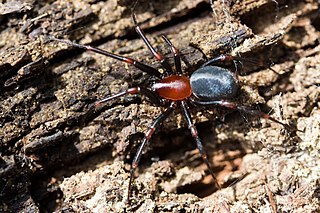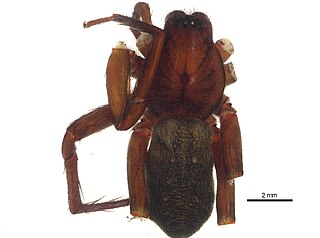
Habronattus is a genus in the family Salticidae. Most species are native to North America. They are commonly referred to as paradise spiders due to their colorful courtship ornaments and complex dances, similar to birds-of-paradise. Males display intricate coloration, while females are cryptic.
Anicius is a monotypic genus of Mexican jumping spiders containing the single species, Anicius dolius. It was first described by Ralph Vary Chamberlin in 1925, and is only found in Mexico.

Homalonychus is a genus of araneomorph spiders, and is the only genus in the family Homalonychidae. It was first described by George Marx in 1891. As of October 2023 it contains only two species: H. selenopoides and H. theologus. They are found in the southern United States and Mexico: H. theologus is mostly found west of the Colorado River, while H. selenopoides is mostly found to the east, with some populations in Death Valley and near Mercury, Nevada.

Kukulcania is a genus of crevice weavers that was first described by Pekka T. Lehtinen in 1967. It is named after Kukulkan, a Mesoamerican serpent deity.

Cesonia is a genus of ground spiders that was first described by Eugène Simon in 1893.

Diguetia is a genus of coneweb spiders that was first described by Eugène Simon in 1895. Members of this genus are six-eyed spiders that are either white or patterned. They are common in the southwestern United States and Mexico, and one species is found in Argentina. In the United States, species have been found in Arizona, California, Nevada, New Mexico, and Texas. These spiders build a tubular retreat at the tip of their tent-like webs. Once an insect is caught in the web, the spider bites it and injects venom to stop its prey from moving, later wrapping it in silk. Both males and females use stridulation while mating, with females also stridulating when harassed. Two species of jumping spiders feed on its eggs. There are eleven Diguetia species.

Coneweb spiders (Diguetidae) are six-eyed haplogyne spiders that live in tangled space webs, fashioning a cone-like central retreat where they hide and lay eggs. It is a small family, containing only two genera split between a range in the Southwestern United States and Mexico and a range in South America. Members of the genus Diguetia usually build their webs in shrubs or between cactus pads. They have the same eye arrangement as the venomous recluse spiders.

Psilochorus is a genus of spiders in the family Pholcidae.

Caponiidae is a family of ecribellate haplogyne spiders that are unusual in a number of ways. They differ from other spiders in lacking book lungs and having the posterior median spinnerets anteriorly displaced to form a transverse row with the anterior lateral spinnerets. Most species have only two eyes, which is also unusual among spiders. A few species of Caponiidae variously have four, six or eight eyes. In some species the number of eyes will increase when the spiderling changes its skin as it grows towards adulthood.

Plectreurys is a genus of plectreurid spiders that was first described by Eugène Louis Simon in 1893. It is one of only two genera in its family.

Kibramoa is a genus of North American plectreurid spiders that was first described by Ralph Vary Chamberlin in 1924.
Nopsides is a monotypic genus of North American araneomorph spiders in the family Caponiidae, containing the single species, Nopsides ceralbonus. It is one of three nopine species, in addition to Tarsonops and Orthonops, described by Ralph Vary Chamberlin from specimens collected from the Baja California region and nearby islands in 1924. They are active during the night, hiding under large stones of Mexico's deserts and xeric shrublands during the day.
Orthonops is a genus of North American araneomorph spiders in the family Caponiidae, first described by R. V. Chamberlin in 1924.

Phantyna is a genus of cribellate araneomorph spiders in the family Dictynidae, and was first described by R. V. Chamberlin in 1948.
Citharoceps is a genus of spiders in the family Segestriidae. It was first described in 1924 by Chamberlin.
Nodocion is a genus of ground spiders that was first described by R. V. Chamberlin in 1922.
Scopoides is a genus of ground spiders that was first described by Norman I. Platnick in 1989.

Curicaberis is a genus of huntsman spiders that was first described by C. A. Rheims in 2015. Species of this genus are found in North and Central America.
Idionella is a genus of North American dwarf spiders that was first described by Nathan Banks in 1893.

Anachemmis is a genus of North American false wolf spiders that was first described by Ralph Vary Chamberlin in 1919. It was briefly synonymized with Titiotus, but was reconfirmed as its own distinct genus in 1999.













